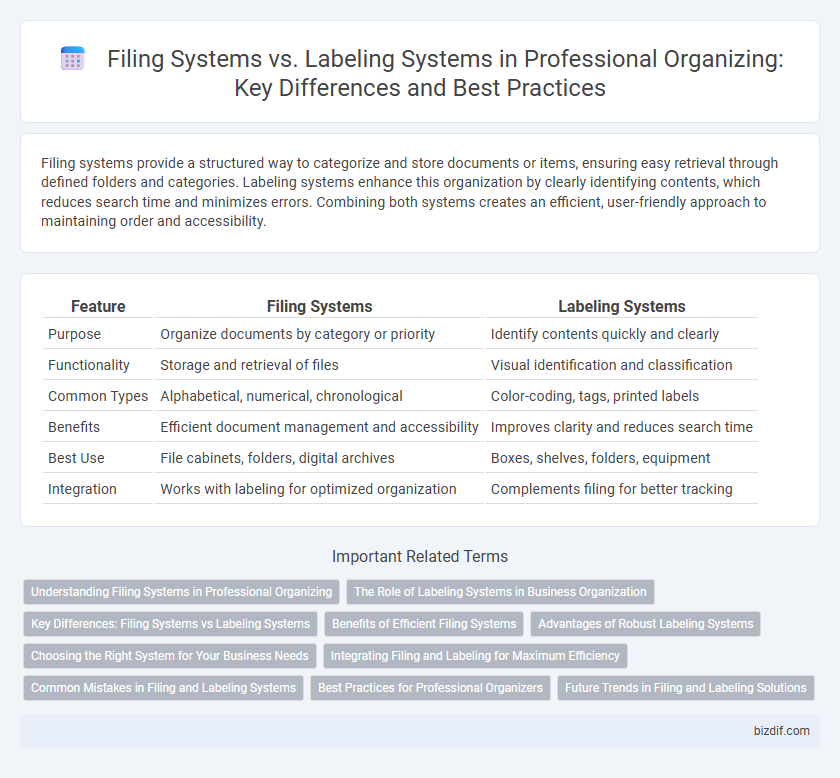Filing systems provide a structured way to categorize and store documents or items, ensuring easy retrieval through defined folders and categories. Labeling systems enhance this organization by clearly identifying contents, which reduces search time and minimizes errors. Combining both systems creates an efficient, user-friendly approach to maintaining order and accessibility.
Table of Comparison
| Feature | Filing Systems | Labeling Systems |
|---|---|---|
| Purpose | Organize documents by category or priority | Identify contents quickly and clearly |
| Functionality | Storage and retrieval of files | Visual identification and classification |
| Common Types | Alphabetical, numerical, chronological | Color-coding, tags, printed labels |
| Benefits | Efficient document management and accessibility | Improves clarity and reduces search time |
| Best Use | File cabinets, folders, digital archives | Boxes, shelves, folders, equipment |
| Integration | Works with labeling for optimized organization | Complements filing for better tracking |
Understanding Filing Systems in Professional Organizing
Filing systems in professional organizing establish structured methods for categorizing and storing documents to enhance accessibility and efficiency. Unlike labeling systems that focus on identification and quick retrieval, filing systems emphasize logical grouping based on project, date, or subject matter to create a coherent workflow. Implementing tailored filing systems can significantly reduce clutter and improve overall productivity in both personal and business environments.
The Role of Labeling Systems in Business Organization
Labeling systems streamline business workflows by enabling quick identification and retrieval of documents, enhancing overall efficiency. Effective labels incorporate clear, consistent terminology aligned with company protocols, reducing errors and saving time during searches. Integrating digital labeling tools with physical filing systems supports seamless organization and improves information management across departments.
Key Differences: Filing Systems vs Labeling Systems
Filing systems organize documents or items into categorized folders or containers, enabling quick retrieval by logical grouping, while labeling systems emphasize clear, visible tags or identifiers to quickly recognize contents without opening containers. Filing relies on structural hierarchy and order, whereas labeling prioritizes visual clarity and ease of identification. Both systems enhance organization efficiency but serve different needs depending on whether access speed or categorization complexity is the priority.
Benefits of Efficient Filing Systems
Efficient filing systems streamline document retrieval, reducing time spent searching for important papers and increasing productivity. They enhance organization by categorizing files logically, which prevents clutter and supports effective information management. Well-designed filing systems also improve security and compliance by ensuring sensitive documents are stored appropriately and easy to audit.
Advantages of Robust Labeling Systems
Robust labeling systems enhance professional organizing by enabling quick identification and retrieval of files, reducing time spent searching through documents. Clear, consistent labels improve accuracy in filing, minimizing errors and misplacement of important records. Effective labeling supports scalability, making it easier to expand or reorganize systems without confusion or disruption.
Choosing the Right System for Your Business Needs
Selecting an effective filing versus labeling system hinges on the specific organizational demands of your business, with filing systems excelling in comprehensive document storage while labeling systems enhance quick identification and retrieval. For businesses handling vast volumes of paperwork, a structured filing system integrated with clear, consistent labels increases efficiency and reduces misplacement risks. Tailoring the system to match workflow patterns and document types ensures optimal productivity and smoother operational management.
Integrating Filing and Labeling for Maximum Efficiency
Integrating filing and labeling systems enhances professional organizing by streamlining document retrieval and minimizing errors. Utilizing consistent labeling across categorized files ensures quick identification and supports maintaining an organized workspace. Combining digital and physical filing with clear labels boosts overall efficiency and reduces time spent searching for important documents.
Common Mistakes in Filing and Labeling Systems
Common mistakes in filing and labeling systems include inconsistent naming conventions, which hinder quick retrieval and reduce overall efficiency. Overly complex or vague labels confuse users, causing misfiling and lost documents. Neglecting regular maintenance leads to outdated files cluttering the system, diminishing both accessibility and productivity.
Best Practices for Professional Organizers
Effective professional organizers implement filing systems that prioritize categorization by project, date, or client name to ensure rapid retrieval and reduce clutter. Labeling systems should use clear, concise, and consistent terminology with legible fonts to enhance visibility and minimize errors. Combining color-coded labels with digital indexing software represents a best practice that optimizes organization efficiency and client satisfaction.
Future Trends in Filing and Labeling Solutions
Future trends in filing and labeling systems emphasize digital integration and automation to enhance efficiency and accuracy in document management. Smart labeling technologies, such as RFID and QR codes, are becoming standard, allowing seamless tracking and retrieval within hybrid physical-digital filing systems. Enhanced software solutions incorporate AI-driven categorization and predictive filing, transforming traditional practices into dynamic, scalable organizational frameworks.
filing systems vs labeling systems Infographic

 bizdif.com
bizdif.com